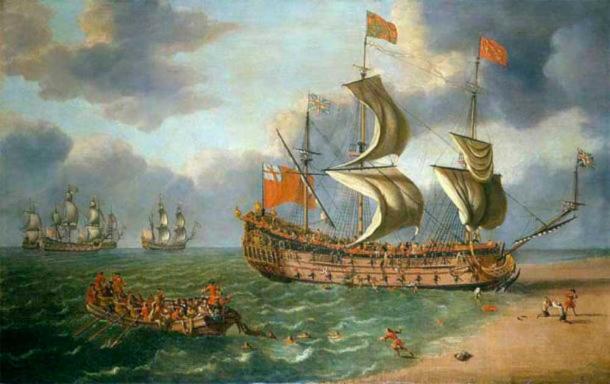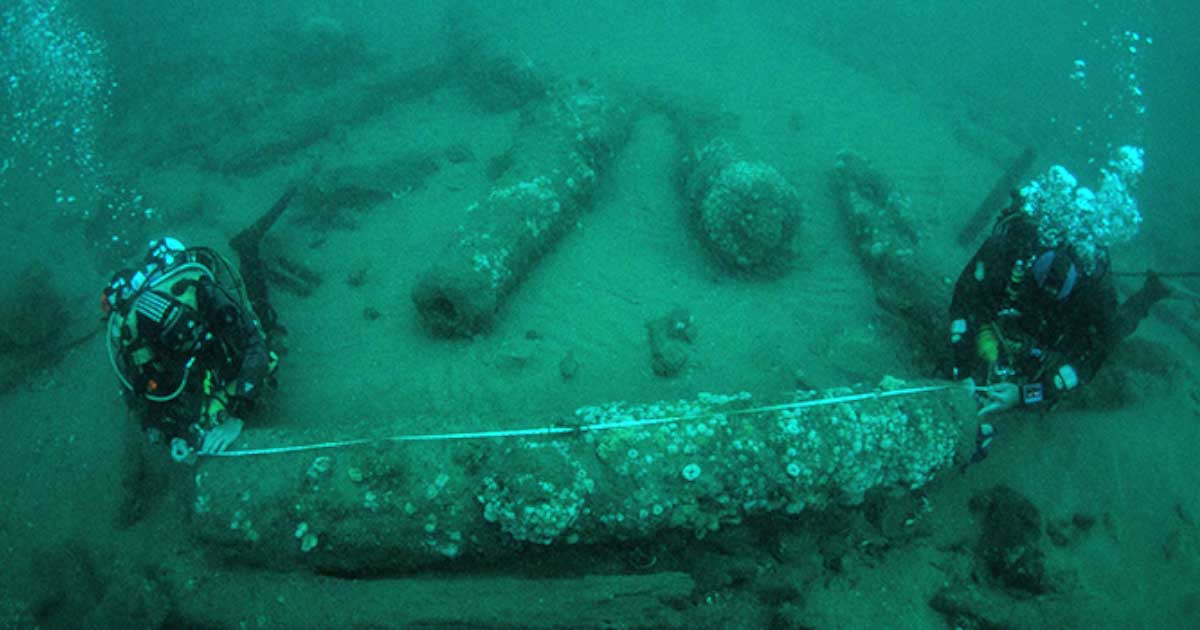Film Footage Provides Intimate View of HMS Gloucester Shipwreck
Archaeologists have been able to take a closer look at one of the United Kingdoms most famous shipwrecks. Stunning underwater footage has provided up-to-now unknown vistas of the abandoned remains of HMS Gloucester, best remembered for almost taking the life of the future king of England when it sank to the bottom of the North Sea on May 6, 1682.
Divers from the Maritime Archaeology Trust made the revealing digital film during onsite examinations of the shipwreck site in 2022. They also took thousands of crystal-clear photographs that will be used to produce three-dimensional images of what is left of the Gloucester, which has been permanently anchored in its current undersea position for more than three centuries.
- 8 Lost Shipwrecks That Still Hold Promise of Treasure and Fame
- Rebuilding the Newport Ship: The Welsh Shipwreck Rivalling the Mary Rose
“Until now, only a handful of people have been able to see what the Gloucester wreck site looks like,” University of East Anglia History and English professor Claire Jowitt, who has been leading the study of the shipwreck and its remains, said in a University of East Anglia press release. “This footage, together with the artifacts and ongoing historical research, will help underline the importance of Britain’s maritime heritage to our island story.”
'The Last Voyage of the Gloucester' exhibition is proud to display 'The Burning of the Royal James at the Battle of Solebay' by Van de Velde the Younger. A dramatic and captivating painting kindly loaned by @schpvrtmsm pic.twitter.com/tcWMsdnIZ1
— The Gloucester Project (@gloucesterwreck) February 27, 2023
HMS Gloucester: A Shipwreck that Almost Changed the Course of History
When the smashed hull and keel of HMS Gloucester were located 28 miles (45 km) off the coast of Great Yarmouth in Norfolk County in 2007, it would turn out to be Britain’s most important underwater archaeological find since the Mary Rose was discovered in 1971. Now archaeologists know more about the state of the wreckage than they ever have before, as a result of the extensive underwater film and photographic survey that was carried out last year.
The sinking of HMS Gloucester could have irrevocably altered the course of British history. The future King James II of England and King James VII Scotland, was on board that fateful day. The Duke of York, James Stuart, was on his way to Edinburgh to pick up his wife and bring her back to London when HMS Gloucester sank to the bottom of the sea.
The future king was able to escape the doomed ship in the nick of time after HMS Gloucester crashed into an undetected underwater sandbank. Thanks to his narrow escape, he was able to ascend to the throne just three years later, becoming the last Catholic monarch to serve the lands of the United Kingdom.
But many others on board HMS Gloucester were not so lucky. Somewhere between 130 and 250 people are believed to have perished in the maritime catastrophe, making the loss of HMS Gloucester one of the deadliest shipwrecks to occur on North Sea waters.

Portrait of James, Duke of York, who almost perished when the HMS Gloucester sank off the coast of Great Yarmouth, by Henri Gascar. (Public domain)
HMS Gloucester Exposes the Pitfalls of Working Underwater
Because of the difficulty in authenticating ancient shipwrecks and working with sunken remains, it was only last year that underwater archaeologists finally confirmed with 100-percent certainty that they had indeed found the long-lost HMS Gloucester.
“The deep water within which the site lies and the low visibility provided challenging conditions for site surveys,” said Garry Momber, Director of the Maritime Archaeology Trust who supervised the underwater film and photography project. “However, every minute spent underwater on such a historically important site was invaluable, allowing us to take almost 7,000 photographs during the diving mission in 2022 to record the wreck in fine detail, and enable the creation of a 3D model.”
As the new film shows clearly, HMS Gloucester is split down the keel, while much of what remains of its hull is buried in the sand. The film contains images of the ship’s anchor, a cannon and some roping, along with shots of various features that demonstrate how the ship was designed and constructed.
Considering the immense passage of time, the submerged remains of HMS Gloucester are in remarkably good condition. The shifting sands of the North Sea have covered and uncovered the wreck numerous times, helping protect it from erosion and other corrosive underwater forces. Many of its artifacts have also been beautifully preserved, thanks to the oxygen-free environment of the ocean waters.

The Wreck of the Gloucester off Yarmouth, by Johan Danckerts. The shipwreck of HMS Gloucester took place on the 6th May 1682. (Public domain)
Remembering the Last Voyage of HMS Gloucester
The announcement and introduction of the new footage has been timed to coincide with the opening of the first public display of artifacts recovered from the shipwreck. This intriguing exhibition is entitled The Last Voyage of the Gloucester: Norfolk’s Royal Shipwreck, 1682 and will be on display from the 25th February 2023 until September the same year at the Norwich Castle Museum and Art Gallery in Norwich, East Anglia.
Artifacts on display and recovered from HMS Gloucester include clothing, shoes, navigational equipment, glass bottles and the ship’s bell, the latter of which was used to officially identify the wreck. Meanwhile, the underwater footage released this week will be included as part of a more extensive video presentation.
Busy @gloucesterwreck morning ahead ... catch me talking about @NorfolkMuseums 'Last Voyage of the Gloucester' exhibition (opening TODAY!) on @BBCRadioFive just before 7am & then @BBCRadio4 Today programme about 7.40am (hopefully!) pic.twitter.com/9kTea5gI8U
— Claire Jowitt (@clairejowitt) February 25, 2023
Many visitors who come to see the remains of the shipwreck are attracted by its most notable passenger, who barely escaped the sinking vessel in a series of events that could have altered the line of succession to the British throne.
- Elizabethan-Era Ship Found in Quarry Lake Along English Channel Coast
- England’s Oldest Known Shipwreck Found, With A Morbid Cargo
Neither the Maritime Archaeology Trust nor the University of East Anglia have plans to raise the remains of the shipwreck and remove them from the sea. But vivid film and photographic surveys of the site will still provide scholars and citizens with an intimate and detailed look at one of the United Kingdom’s most historically important shipwrecks.
“Now the public can see through the murk to the collapsed ship on the seabed and gain an insight into the archaeological potential that remains,” Momber stated. “Significantly, we can also see the impact of shifting sands that are covering and uncovering different areas of the ship, exposing it to ongoing degradation.” HMS Gloucester may not last forever, but it should be around long enough to reveal at least a few more of its fascinating secrets.
Top image: Underwater archaeologists measuring the cannon of the sunken HMS Gloucester. Source: Maritime Archaeology Trust / Norfolk Historic Shipwrecks Ltd.
By Nathan Falde



















